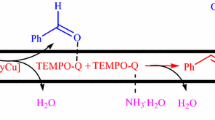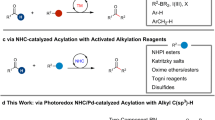Abstract
\(\begin{array}{l}{\hbox{R}^1\hbox{R}^2\hbox{CHOH}} \\ {\hbox{RCH}_2\hbox{OH} }\end{array} \dynrightarrow{Oxone}{\hbox{CH}_3\hbox{CN/H}_2\hbox{O}, 70^{\circ}\hbox{C}} \begin{array}{l}{\hbox{R}^1\hbox{R}^2\hbox{CO}} \\ {\hbox{RCOOH}} \end{array}\) A simple and environmentally friendly procedure for the oxidation of alcohols is presented utilizing Oxone® (2KHSO5 · KHSO4 · K2 SO4) as oxidant and polymer-supported 2-iodobenzamide as catalyst in CH3CN/H2O mixed solvents.
Similar content being viewed by others
Explore related subjects
Discover the latest articles, news and stories from top researchers in related subjects.Avoid common mistakes on your manuscript.
One of the most common reactions in the chemistry is the oxidation of alcohols to the corresponding carbonyl compounds. These compounds represent important intermediates for the preparation of various other useful chemicals. Despite the availability of a variety of methods, there is a growing need for green methodologies that obviate the use of copious amounts of heavy metal oxidants and environmentally unfriendly halogenated solvents [1]. In this case, hypervalent iodine reagents, especially 1-hydroxy-1,2-benziodoxole-3(1H)-one-1-oxide (IBX) have attracted more and more interests [2]. The major drawbacks of IBX, however, are its virtual insolubility in common organic solvents except dimethylsulfoxide and the use of excess reagent in the reaction and thus produces large amount of by-products which result in the difficulties in separating the products. Polymer-supported reagents have found widespread utility in organic synthesis. The attachment of a chemical reagent to an insoluble polymer matrix enables easy reaction work-up. A simple filtration process allows the product to be recovered and moreover recovery of the spent reagent enables it to be recycled, thus meeting the requirements of environmentally friendly chemistry. Several syntheses of solid-supported IBX have been published recently and the reagent could be used in several other organic solvents except DMSO [3]. Although this progress extended the scope of the applications of IBX, the low loading (generally less than 1 mmol/g) and the demand for the huge amount of the supported IBX for the large scale oxidation of alcohols make it impossible to transfer this method to automated high through-put applications. For example, the complete oxidation of 1 g of benzylalcohol generally needs 20–25 g supported IBX.
Oxone® which commercially available as a mixture of 2KHSO5 · KHSO4 · K2SO4 was used for the oxidation of several organic compounds such as sulfides, amines, and alkenes [4]. Bolm reported that TEMPO/Oxone®/n-Bu4NBr is effective for the oxidation of alcohols [5]. Bagherzadeh reported that the oxidation of alcohols to their corresponding aldehydes and ketones could be carried out with Oxone® catalyzed by mer-tris- [(2-oxazolinyl) phenolato] manganese (III), Mn (phox)3 using 2 equiv. of the oxidizing component of Oxone® [6]. Maradur oxidized aliphatic and benzylic alcohols with Oxone® catalyzed by 12-tungstocobaltate (II) [7]. Oxone® was also used to prepare IBX which is a effective oxidant for the oxidation of alcohols (One mole pure IBX needs 3 mole Oxone®, 1.5–6 equiv. of IBX is generally used for the oxidation of alcohols) [8]. In a previous report, we described a procedure for the oxidation of alcohols in that we used tetra-n-butyl ammonium Oxone® n-Bu4NHSO5 as oxidant [9]. Recently Thottumkara et al. demonstrated catalytic use of IBX in the presence of Oxone® for the oxidation of primary and secondary alcohols in user-and eco-friendly solvent mixtures [10]. This interesting report inspired us to exploit a new and more convenient procedure for the oxidation of alcohols utilizing commercially available Oxone® as oxidant and polymer-supported hypervalent iodine as catalyst.
In this article, we report a mild and efficient protocol for the oxidation of primary and secondary alcohols. The catalyst we used is a polystyrene-supported 2-iodobenzamide which could be prepared in large scale in a very simple manner without the use of any expensive chemicals. After the oxidation, the catalyst can be easily separated from reaction mixture and recycled. Aminomethylated polystyrene (1.39 mmol/g 100–200 mesh); crosslinked with 2% divinybenzene was obtained from NanKai University. The resin was pre-swollen with DMF solvent at room temperature for 0.5 h. 2-Iodobenzoic acid was coupled to the resin by the standard coupling method affording 2-iodobenzamide resin (Scheme 1) [11].
Polystyrene-supported 2-iodobenzamide was investigated by IR and weight change [11a, 12]. In the IR spectra of polystyrene-supported 2-iodobenzamide (figure 1), the strong absorption peaks at 1660 cm−1 is attributed to C=O stretching vibration of carbonyl group and this indicated that 2-iodobenzamide has been linked to the polymer. After the reaction, the weight of the polymer increased from 0.500 g to 0.615 g. We calculated from this weight change that the loading of 2-iodobenzamide which is corresponding to the loading of iodine is about 1.00 mmol/g.
A typical reaction was carried out as follows: alcohols (0.10 mmol), Oxone® (2KHSO5 · KHSO4 · K2SO4) (1.3 equiv. to alcohol) and polymer-supported 2-iodobenzamide resin (15 mg, 7.5 × 10−3mmol) were put in CH3CN/H2O (2 mL/1 mL). The mixture was stirred for 16 h at 70 °C. Formation of products and consumption of substrates were monitored by TLC. The identity of products was determined by GC/MS analysis. The conversion and product selectivity were determined using GC analysis. The results are shown in table 1.
Having established an effective oxidation protocol a series of alcohols were treated with Oxone® and polymer-supported 2-iodobenzamide resin. Benzyl alcohol, 4-chlorobenzyl alcohol and 3-methylbenzyl alcohol were easily oxidized to the corresponding aldehyde and acid within 16 h, Benzhydrol, 4-methylbenzhydrol, 4-chlorobenzhydrol, could completely transform to the corresponding ketones in 16 h. Oxidation of secondary alcohols to ketones are not complicated by the undesired accompaniment of Bayer-Villiger oxidation of ketones due to the presence of Oxone® in the reaction. To chain alcohols, conversion gradually reduced from 81% to 47% as which the chain increased from 6 to 16. In order to investigate catalyst recycling, the polymer-supported 2-iodobenzamide was separated by filtration after each oxidation and used for another batch of oxidation. The reactions were carried out with used polymer-supported 2-iodobenzamide in CH3CN/H2O (2 mL/1 mL) at at 70 °C for 16 h using 4-chlorobenzyl alcohol as substrate. When the catalyst is repeatedly filtered out and submitted to a new reaction batch without any further treatment, the activity is lowered to 91%, 80%, and 72% from the original 92% after 2, 3, and 4 cycles respectively. The results suggest that the catalyst can be recycled for at least 4 cycles.
In summary, we have developed a powerful and versatile oxidation system which is particularly suitable for the oxidation of alcohols under mild conditions to the corresponding acid and ketones. This method could reduce the dosage of iodinane and prevent organic iodine from losing. The catalyst can be prepared in large scale in a very simple manner and can be recycled. The oxidation procedure is mild and environmentally benign.
References
(a) R. Noyori and M. Aoki, Chem. Commun. (2003) 1977; (b) G.-J.T. Brink, I.W.C.E. Arends, R.A. Sheldon (2000) Science 287:1636.
(a) A. Varvoglis, Hypervalent iodine organic synthesis, (Academic, San Diego, 1999); (b) T. Wirth and U.H. Hirt, Synthesis (1999) 1271.
(a) W.J. Chung, D.K. Kim and Y.S. Lee, Tetrahedron Lett. (2003) 44:9251; (b) M. Mu’lbaier and A. Giannis, Angew. Chem. Int. Ed. 40 (2001) 4393; (c) G. Sorg, A. Mengel, G. Jung and J. Rademann, Angew. Chem. Int. Ed. 40(2001) 4395; (d) Z. Lei, C. Denecker, S. Jegasothy, D.C. Sherrington, N.K.H. Slater and A.J. Sutherland, Tetrahedron Lett. 44 (2003) 1635.
(a) M.E. Brik, Tetrahedron Lett. 36 (1995) 5519; (b) B.M. Trost and R.J. Braslau, Org. Chem. 53 (1988) 532.
C. Bolm, A.S. Magnus and J.P. Hilderbrand, Org. Lett. 2 (2000) 1173.
M. Bagherzadeh, Tetrahedron Lett. 44 (2003) 8943.
S.P. Maradur, S.B. Halligudi and G.S. Gokavi, Catal. Lett. 96 (2004) 165.
M. Frigerio, M. Santagostino and S.J. Sputore, Org. Chem. 64 (1999) 4537.
Z.Q. Lei, Y.X. Yang and X.Z. Bai, Adv. Synth. Catal. 348 (2006) 877.
(a) A.P. Thottumkara, M.S. Bowsher and T.K. Viond, Org. Lett. 7 (2005) 2933; (b) R.D. Richardson and T. Wirth, Angew. Chem. Int. Ed. 45 (2006) 4402; (c) B.R. Travis, M. Sivakumar, G.O. Hollist and B. Borhan, Org. Lett. 5 (2003) 1031.
(a) W.J. Chung, D.K. Kim and Y.S. Lee, Tetrahedron Lett. 44 (2003) 9251; (b) W.J. Chung, D.K. Kim and Y.S. Lee, Synlett 14 (2005) 2175.
Z.Q. Lei, H.C. Ma, Z. Zhang and Y.X. Yang, React. Funct. Polym. 66 (2006) 840.
Acknowledgments
This work was financially supported by National Natural Science Foundation of China (No. 20174031) and University Doctoral Foundation (20050736001) from Ministry of Education. We also thank Key Laboratory of Eco-Environment-Related Polymer Materials (Northwest Normal University), Ministry of Education, for financial support.
Author information
Authors and Affiliations
Corresponding author
Rights and permissions
About this article
Cite this article
Lei, Z., Yan, P. & Yang, Y. A simple and efficient oxidation system for the oxidation of alcohols utilizing Oxone® as oxidant catalyzed by polymer-supported 2-iodobenzamide. Catal Lett 118, 69–71 (2007). https://doi.org/10.1007/s10562-007-9147-0
Published:
Issue Date:
DOI: https://doi.org/10.1007/s10562-007-9147-0






